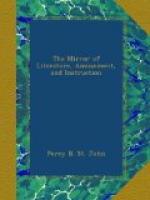Amongst the papers of the learned Dr. Gale, late Dean of York, was found this epitaph of Robin Hood, written in old English:
Hear underneath this laitl stean,
Laiz Robert, Earl of Huntingtun,
Near arcir ther az hie sa goud
An pipl kauld im Robin Heud,
Sick utlawz az hi an iz men
Wil England nivr si agen.
Obiit 24—kal dekembris, 1247.
There is an odd story related of this tombstone: that a certain knight taking it into his head to have it removed and placed as a hearth-stone in his great hall, it was laid over night, but the next morning it was surprisingly removed on one side; it was again laid a second and third time, and as often turned aside. The knight thinking he had done wrong by removing it, ordered it should be drawn back again, which was performed by a pair of oxen and four horses, when twice the number could scarce remove it before.
(To be concluded in our next.)
* * * * *
ANECDOTE GALLERY.
* * * * *
HENRY BROUGHAM.
In the year ——, as Wull, or William Hall, then overseer of the farm of Sunderland, in Selkirkshire, Scotland, the labours of the day being over, was leaning against the dyke of the farm-yard, a young gentleman of genteel appearance came up to him, wished him good evening, and observed that the country here looked beautiful. The two getting into conversation, Hall, who was a talkative lad, after a few observations, asked him “where he was ga’in?” He said he intended going to Jedburgh; “and what business hae ye at Jeddart?” says Wull. “Oh,” says the gentleman,




